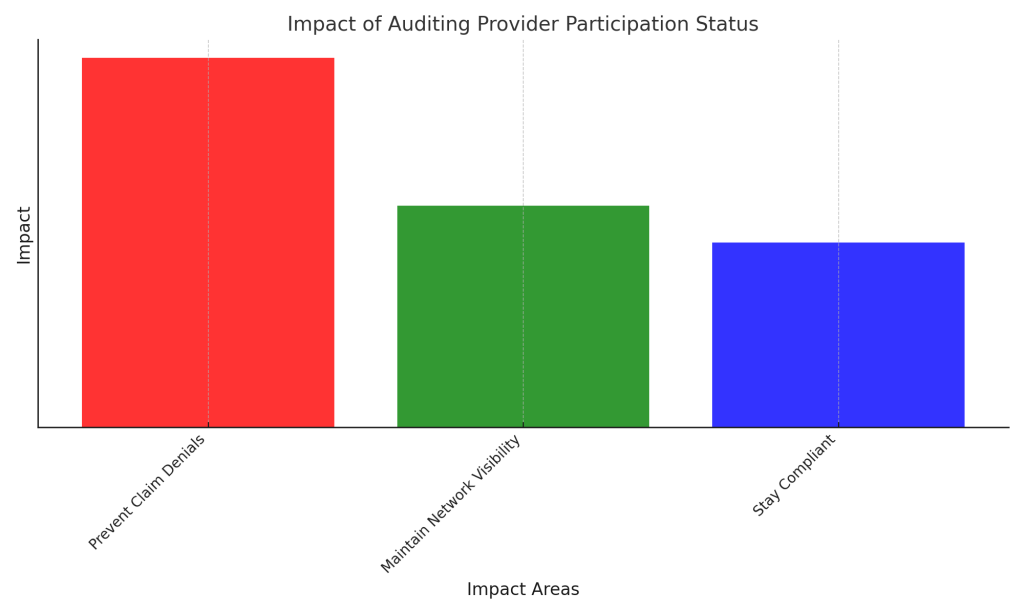For healthcare providers and practice managers, maintaining accurate participation status with payers is critical. Whether you’re in-network or out-of-network, your participation status directly impacts patient access, reimbursement rates, and your practice’s overall financial health. Despite its importance, this is an area that often doesn’t get the attention it deserves.
In this article, we’ll explore why auditing participation status is essential, the risks of overlooking it, and how you can take actionable steps to ensure everything is accurate.
Auditing Provider Participation Status with Payers: A Guide for Providers and Practice Managers
For healthcare providers and practice managers, maintaining accurate participation status with payers is critical. Whether you’re in-network or out-of-network, your participation status directly impacts patient access, reimbursement rates, and your practice’s overall financial health. Despite its importance, this is an area that often doesn’t get the attention it deserves.
In this article, we’ll explore why auditing participation status is essential, the risks of overlooking it, and how you can take actionable steps to ensure your providers and organization is set up correctly with the various payers.
Why Should You Audit Provider Participation Status?
Your participation status with payers dictates how claims are processed. You can be contracted as an organization while having numerous providers non-par or out of network. If you’re interested in losing patients, make sure to send them an out-of-network bill when they’ve assumed you’re in-network. It’s about more than avoiding administrative headaches—it’s about protecting your revenue and ensuring a seamless patient experience.
Here’s why auditing is worth your time:
- Prevent Claim Denials:
Participation status errors can lead to claims being processed incorrectly or outright denied. This often happens when a provider is mistakenly flagged as out-of-network or if credentialing lapses. - Ensure Accurate Patient Billing:
Patients expect transparency. If your status doesn’t align with payer records, patients might receive unexpected bills, leading to frustration or even lost trust. - Maintain Network Visibility:
Payer directories are a major source of referrals. If your practice isn’t accurately listed—or worse, not listed at all—potential patients may assume you’re not available to them. - Protect Your Revenue:
Contracted rates and reimbursements hinge on being correctly listed with payers. Errors can lead to underpayments or delays in payments. - Stay Compliant:
Payers regularly update participation and credentialing requirements. Without an audit process, it’s easy to miss critical updates, putting your practice at risk of falling out of compliance.
What Happens If You Don’t Audit?
Skipping regular audits can lead to a snowball effect of issues:
- Claim Processing Problems: Claims may be denied or reimbursed at out-of-network rates, delaying payments and increasing administrative work.
- Revenue Leakage: Small discrepancies in payer contracts can lead to thousands of dollars in lost revenue over time.
- Patient Confusion and Complaints: If patients are billed for out-of-network services they expected to be covered, it can damage your reputation and lead to disputes.
- Contract Risks: Missing recredentialing deadlines or failing to meet payer requirements can result in termination from payer networks.
- Operational Strain: Fixing participation errors retroactively requires significant staff time and resources.
How to Audit Participation Status: Practical Steps
Here’s a step-by-step guide to help you stay ahead of participation status issues:
- Compile Current Contracts and Documentation:
Collect all payer contracts, fee schedules, and credentialing records for your practice. Ensure you have easy access to these documents. - Review Payer Directories:
Look up your practice and provider details in payer directories. Verify that names, locations, specialties, and participation status are accurate and up to date. - Analyze Claims Data:
Identify patterns in claim denials or reimbursement discrepancies. If claims are consistently being reimbursed at out-of-network rates, it could indicate a participation status issue. - Engage Your Credentialing Team:
Ensure your credentialing process includes regular checks of participation status. Pay close attention to recredentialing deadlines to avoid lapses in network status. - Communicate with Payers:
Establish a clear line of communication with payer representatives. Address discrepancies immediately and confirm any updates in writing. - Leverage Technology:
Use credentialing and revenue cycle management software to automate data tracking and reminders for recredentialing or contract updates. - Schedule Regular Audits:
Set a schedule for participation status audits—quarterly is a good starting point. Frequent checks ensure you catch and resolve issues quickly.
What Insights Can You Gain?
Auditing your participation status doesn’t just prevent problems; it also provides valuable insights to optimize your practice:
- Patient Demographics and Demand:
Understand which payers drive the most patient volume and tailor your participation strategy accordingly. - Contract Performance:
Spot reimbursement rates that don’t match your contracted agreements and take action to resolve underpayments. - Credentialing Gaps:
Identify missing or outdated information that could jeopardize your network status. - Opportunities for Growth:
Pinpoint gaps in payer networks where you could expand your participation to attract more patients.
Conclusion
Auditing your provider participation status is one of the most effective ways to protect your revenue, enhance patient satisfaction, and maintain compliance with payer requirements. It’s not just about finding mistakes—it’s about ensuring your practice operates at its full potential.
By taking a proactive approach and following these practical steps, you can empower your practice to stay ahead of challenges, avoid costly errors, and position yourself as a trusted provider within payer networks.
Remember: a little time spent auditing now can save you a lot of headaches (and revenue) down the road.
Don’t hesitate to contact us if you would like assistance auditing your provider participation status with the payers.


